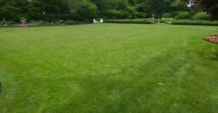Well the leaves are just about finished falling from our deciduous trees! I love this time of year with the cool crisp air of fall and the color of leaves from yellow to red to purple and orange!
I am always amazed at how many leaves can fall from one tree. And what is the value of those leaves in the landscape? The leaves of one large shade tree can be worth as much as $50 of plant food and humus. Pound for pound, the leaves of most trees contain twice as many minerals as manure. For example, the mineral content of a sugar maple leaf is over five percent, while even common pine needles have 2.5 percent of their weight in calcium, magnesium, nitrogen and phosphorus, plus other trace elements.
One nutrient in high quantity in fallen leaves is carbon. Most people are familiar with nitrogen as the main ingredient in most fertilizers, being unaware that plants use carbon in much higher quantities than nitrogen. Typically, plants readily take in carbon dioxide from the air, but root uptake of carbon from the soil also happens. A soil with an abundance of carbon will be dark and earthy, providing spaces for plant roots. Shredded leaves are an excellent addition to soils for vegetable and annual flower gardens, as well as preparation for new gardens. Giving the garden a quick rough turn with the potato fork will incorporate leaves and begin them in the process of decomposition.
Composting is an easy process and doesn’t require any expensive bins or tumblers, just a good mix and time. The compost pile can be any size but we have found that a 5 ft X 5 ft size bin is the minimum, and can be loose or fenced in with some chicken wire, just make sure you can access it from one side to turn your pile every so often. Turning your pile will allow oxygen to help the decomposition process.
Start with a 6 inch layer of leaves that are either shredded or not, and then add a two inch layer of something green that contains more nitrogen such as manure, grass clipping, green weeds, or vegetable waste from the kitchen. If you don’t have green waste, then add a little nitrogen such as dried blood, cottonseed meal, or bone meal. You can also spread a little native soil between the layers which will add some bacteria, fungi and other organisms that will help decompose the organic waste. Turn your pile every three weeks or sooner if you want. If you turn the pile three or four times before spring, you can have some fine compost ready for spring planting.
Once you have compost, use it in your garden or landscape by incorporating into planting soils or topdressing a planting bed or garden. The compost will improve soil structure, loosening compacted clay soils that have trouble draining or helping sandy soils hold moisture and nutrients.





